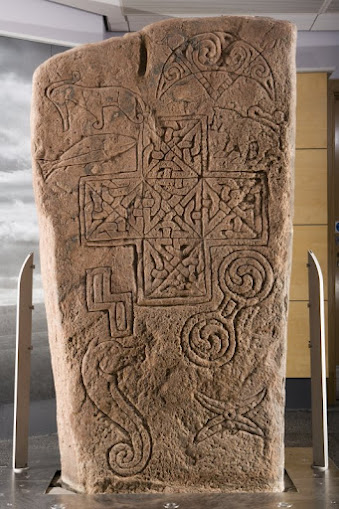The Ulbster Pictish stone
 |
| The Ulbster Pictish stone www.canmore.org.uk |
In the far north of Scotland, there’s a fascinating Pictish stone. The stone was found at a place called Ulbster on the east coast of Caithness. It’s a Class II stone, which dates to around the 8th/9th centuries. There’s a Christian cross on one side, with animals, and another Christian cross on the other side, with four symbol pairs. This is the most symbols on any Pictish stone in Scotland. There’s a crescent moon and V rod and an animal below, at the top of the stone. The crescent moon and V rod is a common symbol in the far north of Scotland. There’s a Pictish beastie and a salmon to the left. These two symbols are found on the Craw stone at Rhynie in Aberdeenshire. There are other symbols like a sea horse and a double disc. The Pictish stone may have been located close to a church or monastery. There are also a number of brochs, cairns and hillforts in the area. The four symbol pairs may represent individuals. They may be the tribal emblems of the chieftains or kings who commissioned the stone. The Pictish stone may have been used for worship or it may have marked the site of a gathering place for the local tribes. The stone may have even commemorated a treaty between four Pictish tribes in the area. In the accompanying text to Blaeu’s Atlas of Scotland, there’s a reference to the four provinces of the bishopric of Caithness.
“The bishopric of Caithness undoubtedly first took this
title from Cattei: for this diocese includes in its ambit not only Caithness,
but also Sutherland, Strathnaver and Assynt, all of which were formerly known
under the one name of Cattei.”
Blaeu Atlas of Scotland, 1654
https://maps.nls.uk/atlas/blaeu/browse/968
These four provinces would have formed the Pictish kingdom of Catt. The Dornoch
Firth would have been the southern boundary. There were also four Celtic tribes
in the area. The Cornavi, in the area of Caithness, the Carini, in the area of
Strathnaver and the west coast, the Lugi, on the east coast of Sutherland and
Caithness and the Smertae, in central Sutherland. Perhaps the four symbol pairs
on the Ulbster stone represent the chieftains of these tribes. When the Vikings
raided the Orkney and Shetland islands and the area of Caithness, the tribes of
Catt may have been driven towards the south. They may have settled in
Strathspey, where they formed the clan Chattan confederation. However, this
would be speculation. The clan Chattan are supposedly descended from someone
called Gillichattan Mor, the great servant of Saint Cathan.
 | |||
| The four tribes in the far north of Scotland. The image is from Ptolemy's map, where Scotland has been tilted to the right. |
-----------------------
If you find these articles interesting, I have a number of books on early Scottish history. They're available on the My Books page.
Comments
Post a Comment